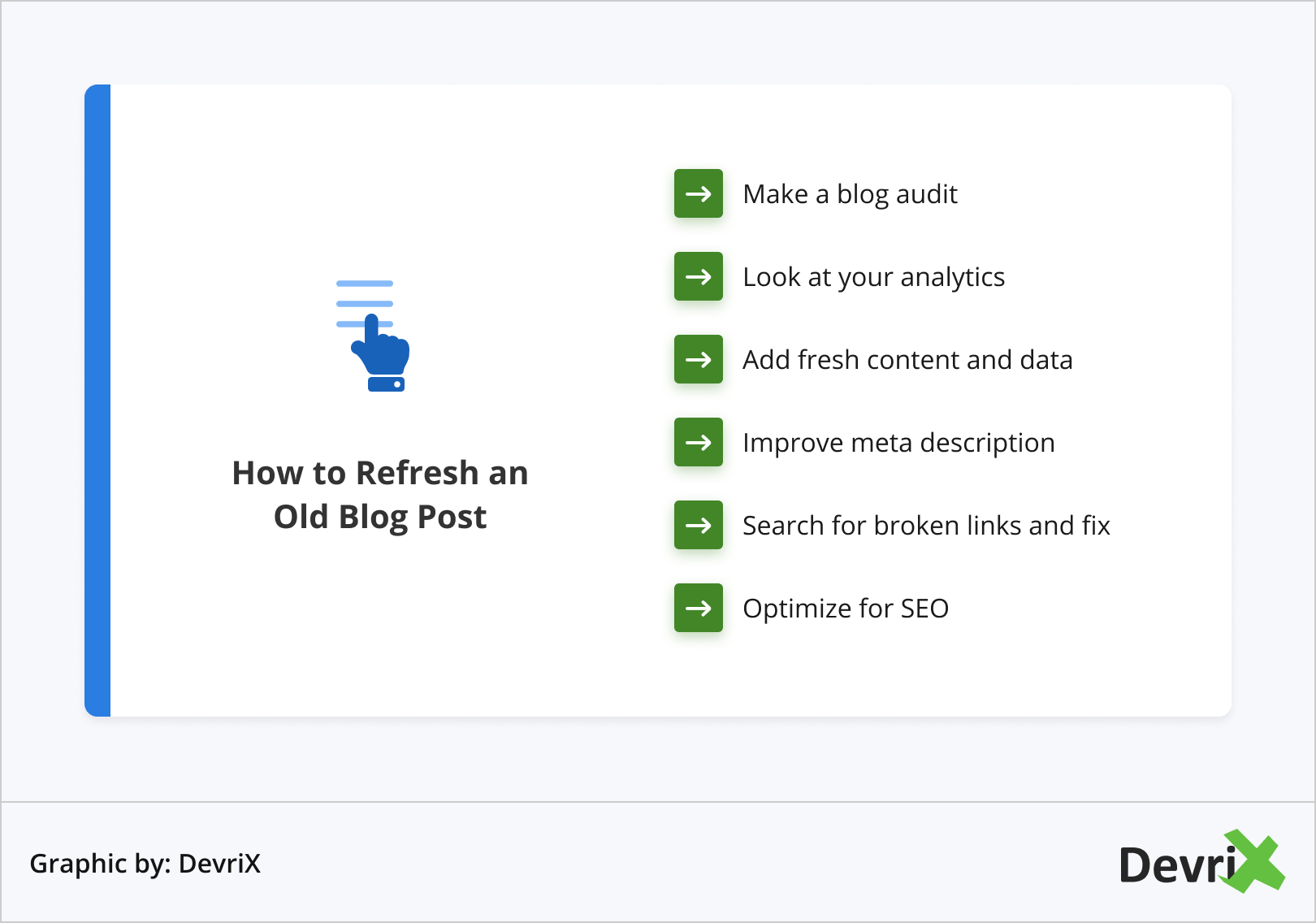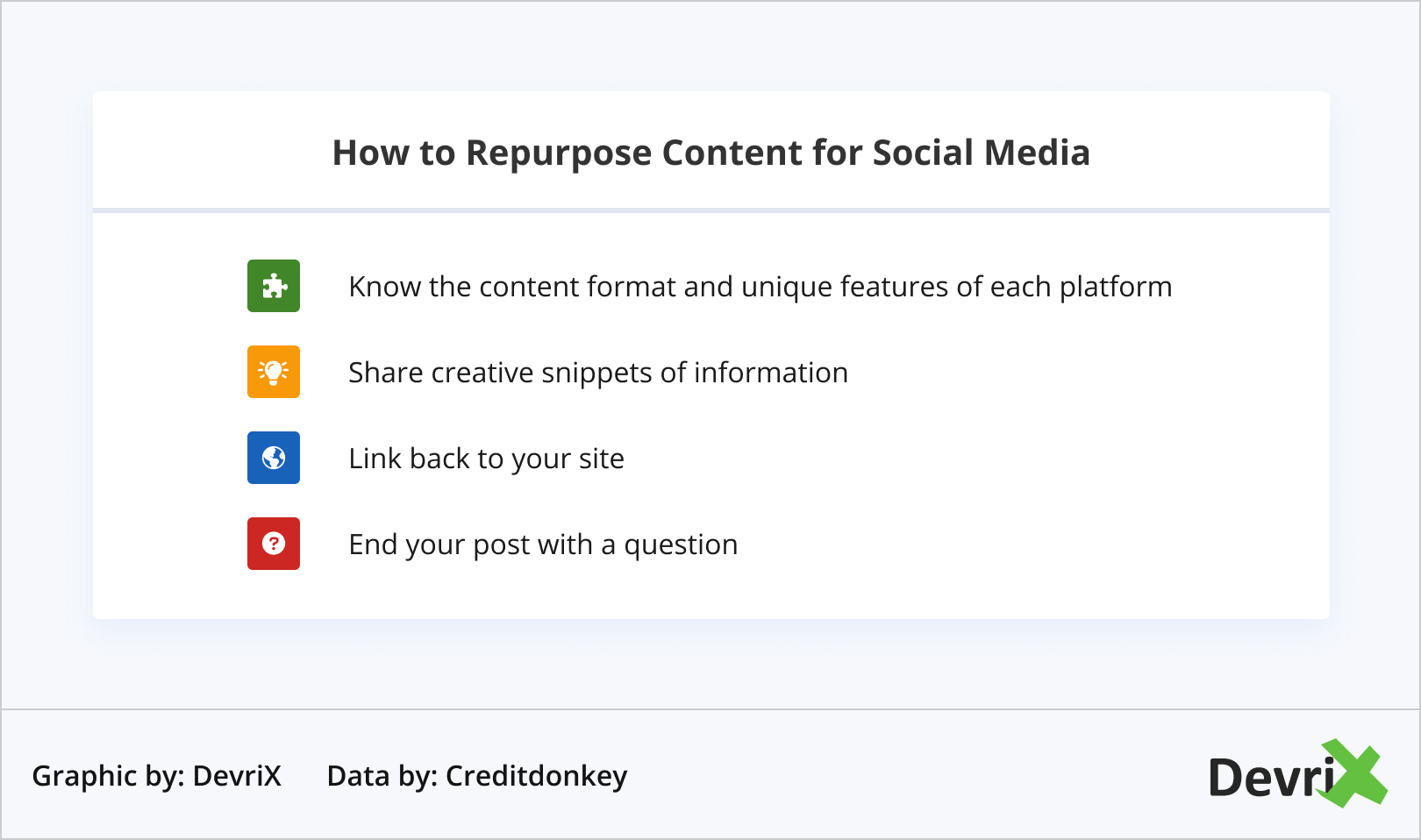As a content marketer, you probably have so much to do and often not enough time to get it done. There is a lot of pressure for delivering high-quality content on a regular basis that audiences really want to see, and with so much at stake, the last thing you want to do is to run out of content ideas.
But don’t worry. If you ever get stuck, all you need to do is repurpose content you already have across your digital channels. You don’t have to create new materials day in and day out. Instead you can focus on bettering what you already have.
Repurposing content allows you to get new organic traffic and reach more potential customers. What is more, it saves you time so you can put more of your energy into other important activities like increasing your sales leads.
When choosing what content to repurpose, take a look at your metrics. Pinpoint what performs well and try to think how you can deliver it again, but in a fresher way. You can revamp any type of content in many different ways – turn blog posts into videos or audio stories, compile research findings into a case study, or break down long-form content into social media posts. Just be careful about duplicating content.
To inspire your repurposing efforts, we have put together some tips and tricks on the best ways to repurpose content across digital channels. Read on to find out more.
Give New Life to Old Blog Ideas
Refreshing old posts should be an important part of any blog’s content strategy. It saves time and lets you shed new light on past ideas. It can generate new traffic and boost your rankings. What is more, it lets you show your audience that you care about the integrity of your content and about creating the best user experience possible.
Before you begin refreshing, conduct a blog audit. Note which of your titles haven’t generated much traffic, and which have had a considerable spike in traffic at one point but don’t anymore. These are the blog posts that would benefit the most from being refreshed so more people will see them.
To choose the right posts to give new life to, start by examining your website analytics. You can look at some common performance metrics such as time on page, goal conversion rate, bounce rate, social shares or backlinks per number of visitors. Then identify which of these posts will make a better impact on your brand and optimize those.
You can also identify which keywords that are topic-related with high search volume and what your piece ranks for in the Google Search Console. Then look at the trends on Google Trends or Google Ads Keyword Planner and find the keywords that have the highest potential to boost your rankings and get you new visitors. You can then update the meta description with these keywords and add fresh content to include them in your text so you can boost the organic search traffic to your blog.
Next, you can improve the internal links in your posts so you can funnel readers to the older, but still important topics. This will help you improve user experience as well as search rankings, since your readers get to pick for themselves if they want to read more of your copy or not.

When reviving your content, it’s important that you consider both it’s SEO performance, as well as the value of the included information. The main goal is to drive up traffic and increase your brand’s exposure. So, by making your blog content more engaging you will also make it more attractive to Google.
Create Posts into Videos
You already know that videos are huge right now. People are twice as likely to share video content with their peers compared to any other type of copy available. What is more, 54% of consumers want to see more video content from their favourite brands. So, why not take your written content and present the key points of your material in a video format.
You have complete freedom to decide how to deliver it. You may film yourself speaking or you can create animated videos and add a voice over via online tools. Make sure you script your video and use it as a guide. Don’t be too focused on saying everything word for word. That often makes it feel unnatural and it won’t do much to connect you with your audience, which is the main purpose of a video.
Once you’ve created amazing video content, post it on YouTube and add a link to the page, so it boosts your profile. You can also embed it in your blog post so it compliments the article. This can help you boost your SEO and rank higher in the SERPs as Google can associate the YouTube video with the article. And that’s a win-win for your content strategy.
Record Audio Stories
Similarly to videos, audio stories are getting more and more popular every year. People consume content in different ways. Some like to read, some prefer to watch, and some want to listen. Audio stories are especially useful for busy people, who like learning things while they’re on the go – driving, walking, commuting, working out. So, if you have busy customers who’d like to be educated on a certain topic, an audio story can work really well.
To make a good audio story, browse through your long-form content and pick a topic that can be effectively translated to a voice recording. Just like with video, not every blog post can be turned into an audio story. Some may need more visuals, while others may be a more natural fit to have a conversation about.
It’s good to have a few audio stories ready so you can get your audience hooked. If you have between 3 and 5 stories ready, your listeners can binge them right away. For a maximum engagement you can take a snippet of your audio and post it on one of your social media channels.
Write a Case Study
If you, for example, gather SEO data, social media metrics, or analyze traffic performance, there’s a great content opportunity for you to use this data and write a case study. As a marketer you’re probably collecting lots of types of data, that calls for effective interpretation. So why not use the inferences you draw to learn and present something new in an educational way.
Turning internal data into a case study will showcase your company’s ability to interpret data successfully. Case studies allow you to understand the cause and effect of your business decisions. They can boost your brand’s credibility and help you generate new clients. What is more, you can also repurpose your case study by turning it into a blog post or by adding graphs to your data that you can share in other articles.
You can distribute your case studies through an email campaign to your subscribers. You can also make them available on your website, or introduce them as a special offer on a landing page.
Assemble an Ebook
Another way to boost your brand and content’s credibility is to assemble an ebook. If your business creates large amounts of various quality content such as data reports, templates, interviews, expert opinions, etc. you can put them altogether into a single long-form piece of content.
There are many subject areas you can cover, depending on your industry, expertise and audience. Look at the most visited blog posts and see which are the most popular, then pick a niche title, add a nice intro and assemble the blog pieces. You can make some corrections to match the style of the eBook.
Since your content is already written, publishing an ebook requires less time. So, look for a way to communicate your content in a fun and creative way. Also, make sure you add a balanced mix between organized information and compelling visual support.
Ebooks are a wonderful way to generate new business leads. In most cases ebooks are gated, meaning that if readers want to get their eyes on them they have to provide their name and email address.
Additionally, if you offer a free ebook on a hot topic in your industry you can drive more traffic to your website. This can be as simple as including links to corresponding landing pages on your site so users can gain more insights about your brand.
Create a Webinar
If you really want to take your video content up a notch and provide an even better learning experience, you can consider creating a webinar or an online course. Since you already have a large body of content, you can divide it into different groups, like “local marketing”, “ultimate guide to…” and so on, then turning into a webinar. Alternatively, if your business has a department or a team with specific expertise, you can also get their help.
Webinars are great for providing innovative insights on a niche topic, while highlighting your company’s special expertise. When you foster an educational discussion with your audience, you enable them to connect with your business in a beneficial way. To ensure the utmost engagement, include interactive media and make sure you follow up with your audience after your event has ended.
Design Presentations and Infographics
If you have a dense report with a lot of valuable information and data that you’d like to share, why not repurpose it visually with the help of a few slides of graphs – presentations and infographics.
Presentations offer an easy-to-read recap of your long-form content. They can include meaningful statistics, quotes and advice, and help you translate the key point of complex information to a wider audience.
Infographics are a step beyond simple presentations. They are informative, eye-catching and provide an easy way to share large amounts of information in a concise and clear way. Additionally, they are great for breaking a blog post into a few major talking points.
Share Snippets on Social Media
Repurposing content on social media provides yet another avenue to reach out to new readers and grow your online presence. Social media posts are a great medium for providing an interactive visual experience. In addition to content distribution and promotion, these platforms help build your brand’s credibility, and improve your relationship with your audience.

Repurposing your blog content into a LinkedIn post can be a great edition to your content marketing strategy. LinkedIn articles are actually indexed by Google, which means that you can use them to help prospects discover your business and then direct that traffic to your website.
Before you post your content on LinkedIn, it’s good to wait at least a week after you’ve published your article on your blog. This will help you avoid Google considering your LinkedIn post as duplicate content and can save your rankings. So, give your blog post a head start, and while you do, refresh your LinkedIn post enough so it has its own chance to rank, thus doubling your exposure.
Make sure you link back to your article to get people back to your own platform, in addition to some SEO boost from those links. Leave a room for discussion by ending it with a question that can engage your audience. This will help you deepen your relationship with your followers.
Instagram is a great place to get your content seen, but compared to LinkedIn, it requires a different approach. People go on Instagram to be inspired, and not so much to learn. So, when repurposing your content on this platform, you have to make it intriguing so your audience would want to engage with it.
You can repurpose long-form content by creating multiple Instagram posts. For example, you can create 5-10 instagram posts from one blog article. Or you can crop snippets from your video or audio content to give a little taste of what the full versions are like. You can even go live and share a juicy piece of advice and have a real time discussion with your audience.
Repurposing your blog content to other platforms such as Medium, Pinterest, Twitter, Facebook follows the same approach. You need to know what is the specific content format of each given media. You also don’t run the risk of duplicate content. You can use each platform’s unique features to ensure a highly interactive user experience.
Conclusion
There are plenty of benefits to repurposing content. It’s an easy way to fill in any occurring gaps in your content schedule as you don’t have to produce something new from scratch. It saves you time and can boost your rankings.
When choosing which content to repurpose make a strategic choice. Go back to your analytics data and find your top-performing pieces. Then add a new twist to them so that they can improve your traffic and leads.




